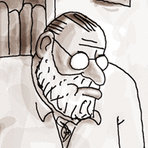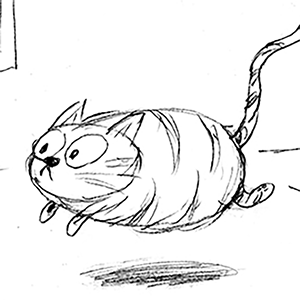NYC restaurateur Keith McNally spills the beans in memoir
Published in Variety Menu
"You are not the kind of girl who would be at a place like this at this time of the morning. But here you are, and you cannot say that the terrain is entirely unfamiliar. You are at a bar talking to a guy with a shaved head. The spot is either the Odeon or Lucky Strike. All might come clear if you could just slip into the bathroom and do a little more Bolivian Marching Powder. Then again, it might not." — heavily cribbed from "Bright Lights, Big City" by Jay McInerney.
If you were in New York in the 1980s, it was hard not to know about Keith McNally's restaurants and night spots. The Odeon's neon sign shone out from the cover of that '80s time capsule "Bright Lights, Big City," fer Chrissake.
Working as a drone at magazines like Spy, Andy Warhol's Interview and The New Yorker — where McInerney worked briefly as a fact checker and upon which he modeled the unnamed publication in his breakout novel — I was not habitually familiar with Bolivian Marching Powder nor the interior of McNally's restaurants, but they were an unmistakable part of the media-sodden landscape.
A 2004 profile in The New York Times christened McNally "The Restaurateur Who Invented Downtown," but not all of his hot spots were Downtown. He was really helping to invent a new kind of nightlife.
As the Studio 54 days turned gradually to the Club Kids epoch of the late '80s, each of his restaurants became stylish scenes, sometimes turning hundreds of tables a night.
Unfortunately, if you are a budding nightlife impresario or McNally wannabe, you will find little instruction in McNally's recent memoir, "I Regret Almost Everything" (Gallery Books, $29.99).
For instance, McNally, 73, attributes the success of The Odeon in Tribeca — his first restaurant, with his brother Brian and his first wife, Lynn Wagenknecht — to "being in the right place at the right time."
"Through no intention of our own, The Odeon quickly became the epicenter of the downtown art scene with Andy Warhol, Jean-Michel Basquiat and Julian Schnabel mixing with the likes of Anna Wintour, Lorne Michaels and the cast of 'Saturday Night Live,'" McNally writes, also name-dropping Harold Pinter, Joseph Heller and Edward Albee as customers at The Odeon, which opened in 1980.
As Times critic Pete Wells has written, McNally's restaurants are not known for their inventive cuisine. McNally's original Pastis restaurant "took almost everything from the stodgiest, least trend-conscious sort of French cafes and brasseries," Wells said in 2019. Two years earlier, in a lukewarm review of Augustine, Wells noted, "By unanimous consent, atmosphere is Mr. McNally's great, unrivaled strength. ... He excels at building rooms that evoke vintage Paris — not exactly the real Paris, but the city the way you remember it a year after taking a vacation there."
In his memoir, it's true, McNally never sings the praises of sourcing local produce or explains the precise crumb a baguette should have. He does stress the importance of a restaurant's having "the right feel": "At its best, the right feel can transport a customer like nothing else."
He speaks of his meticulousness in designing a restaurant's interior, down to the inches of a two-top table and international trips to buy fixtures and furnishings.
But "I Regret Almost Everything" is not about the day-to-day of the restaurant business. (By his count, McNally has opened 19 restaurants.) Rather, it is a lively, plainspoken narrative of his rise from working-class origins in Bethnal Green, London, through turbulent personal times.
He opens his book with his suicide attempt in 2018, having swallowed dozens of sleeping pills he'd been stocking up. On the first page alone, he refers not only to his thwarted attempt — his young son, George, discovered him — but also his rocky marriage to his second wife, Alina, and the 2016 stroke that left him partially paralyzed and with speech difficulties.
He travels back and forth in time from this moment, recounting his parents' unhappy marriage, his acting career as a teenager and young man, and an affair with the older playwright Alan Bennett. He went to New York at 24 with ideas of being a filmmaker, but ended up working his way up in restaurants from busboy at an ice cream parlor to general manager at a fashionable Greenwich Village restaurant.
When he quit in a dispute, he, Wagenknecht and his brother decided to open their own restaurant, choosing Tribeca because it was the only area they could afford. The rest, as they say, is history.
Throughout this journey through his life, McNally is good company, with a dry sense of humor and the instincts to rein in his ego — not shying from naming names (like an account of his Instagram feud with James Corden) but also not sparing himself.
He's also a font of useful aphorisms about life: "I often think that the best thing about having sex with someone is being able to stretch your legs the full width of the mattress when the other person gets up."
Though restaurant owners will not find a recipe for success in these pages (or any recipes at all), they will find a eventful, heartfelt tale. And Balthazar, one of McNally's most successful restaurants, opened in in SoHo in 1997, did share the following food and cocktail recipes below.
Bon appétit !
Le Balthazar
1 ounce Belvedere Vodka
1 ounce Grand Marnier
1/2 ounce fresh lime juice
1/2 ounce simple syrup
2 ounces Champagne Taittinger Brut NV
In a cocktail shaker, combine vodka, Grand Marnier, lime juice, simple syrup and ice.
Shake vigorously. Strain into a chilled coupe glass. Top with Champagne and garnish with a twist of orange peel.
— Balthazar Restaurant
Balthazar Salad
For salad
1 head of Romaine lettuce
1/4 pound of mâche
1 head of frisee
1 head of radicchio
1 fennel bulb, very thinly sliced, preferably on a mandoline
1/4 pound of radishes, thinly sliced
1/2 pound asparagus
1/4 pound haricots verts
1 teaspoon of salt
1/2 teaspoon freshly ground black pepper
1/4 pound ricotta salata
1 Hass avocado, sliced into 6 wedges
1 raw beet, julienned
Zest of 1 lemon
3 slices of brioche, toasted and pulsed in a food processor to a fine crumb
For Lemon truffle vinaigrette
1/2 teaspoon salt
1/4 teaspoon freshly ground black pepper
1/4 cup lemon juice
3/4 cup extra-virgin olive oil
1/4 cup black truffle oil
Tear lettuce leaves and mix with sliced fennel and radishes.
Blanch the asparagus and haricot verts in boiling water until tender, about 6 minutes. Transfer to ice bath, then drain.
Add asparagus and haricot verts to other greens. Separately, combine vinaigrette ingredients in a jar, shake and dress salad. Season to taste with salt and pepper.
Divide the salad among 6 plates, topping each with a slice of ricotta salata, a wedge of avocado, some julienned beet and lemon zest.
Finish with a pinch of bread crumbs, and serve.
Serves 4-6.
— Balthazar Restaurant
©2025 PG Publishing Co. Visit at post-gazette.com. Distributed by Tribune Content Agency, LLC.










Comments